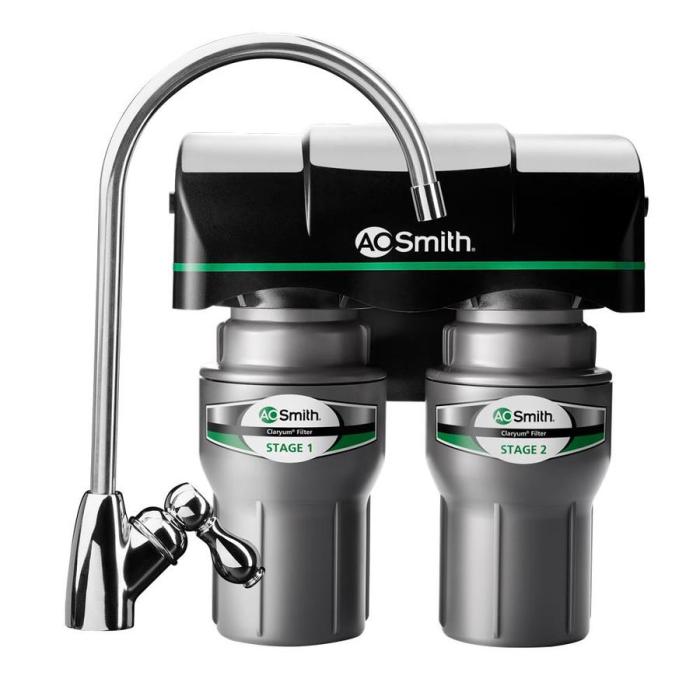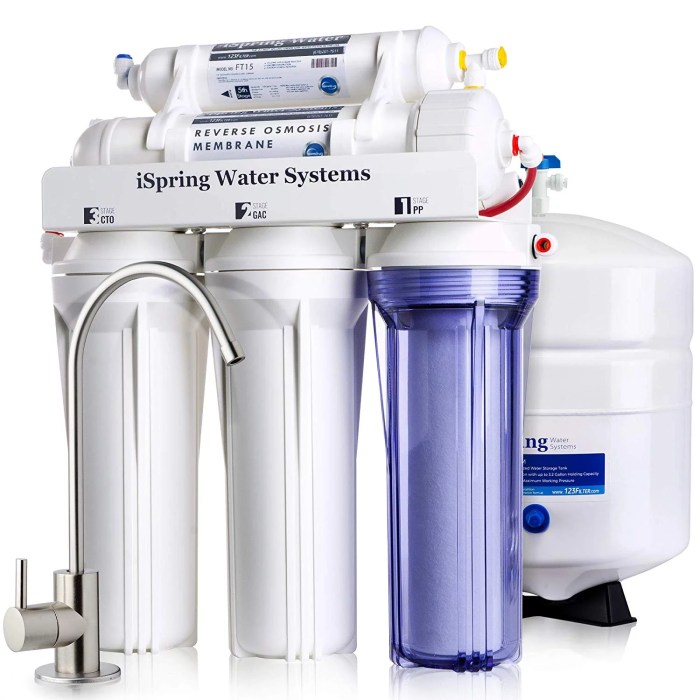In our modern world, access to clean and safe drinking water is essential for maintaining good health. While most of us rely on municipal water systems, the quality of water can vary significantly depending on location and infrastructure. Contaminants such as lead, chlorine, and bacteria can lurk in our water supply, posing potential health risks.
Bathroom sink water filtration systems offer an effective solution to improve the quality of water we use for drinking, brushing our teeth, and washing our hands. These systems remove impurities, enhance taste, and provide peace of mind knowing that the water we use is safe and healthy.
Overview of Bathroom Sink Water Filtration Systems
Bathroom sink water filtration systems are devices installed at the point of use to improve the quality of water coming from bathroom sinks. They are designed to remove contaminants and impurities that may be present in the water supply, such as sediment, chlorine, heavy metals, and bacteria.
According to a study by the Environmental Protection Agency (EPA), approximately 90% of public water systems in the United States meet safety standards. However, even treated water can contain contaminants that can affect its taste, smell, and appearance.
Types of Bathroom Sink Water Filtration Systems
There are several types of bathroom sink water filtration systems available, each with its own advantages and disadvantages:
- Activated Carbon Filters: These filters use activated carbon to remove contaminants through adsorption, a process where impurities stick to the surface of the carbon. They are effective in removing chlorine, taste, and odor but may not be as effective in removing heavy metals or bacteria.
- Ceramic Filters: These filters use a ceramic membrane to physically remove contaminants. They are effective in removing bacteria, cysts, and other microorganisms but may not be as effective in removing chemical contaminants.
- Reverse Osmosis Systems: These systems use a semipermeable membrane to remove contaminants by forcing water through the membrane. They are very effective in removing a wide range of contaminants, including heavy metals, bacteria, and viruses.
Types of Bathroom Sink Water Filtration Systems
Bathroom sink water filtration systems come in various types, each with its own filtration method, efficiency, lifespan, and cost. Here’s a comparative overview of the most common types:
| System Type | Filtration Method | Efficiency | Lifespan | Cost |
|---|---|---|---|---|
| Activated Carbon Filter | Activated carbon adsorbs contaminants | High | 6-12 months | Low |
| Ceramic Filter | Ceramic membrane filters out particles | Moderate | 2-5 years | Moderate |
| Reverse Osmosis (RO) System | Semipermeable membrane removes dissolved solids | Very high | 2-5 years | High |
| Ultraviolet (UV) Disinfection System | UV light kills bacteria and viruses | High (for microorganisms) | 1-2 years | Moderate |
Specific examples of brands or models for each type of system include:
- Activated Carbon Filter: Brita Faucet Mount Filter, Pur Faucet Filter
- Ceramic Filter: Doulton Ceramic Filter, Berkey Gravity-Fed Filter
- Reverse Osmosis (RO) System: Culligan RO-300, iSpring RCC7AK
- Ultraviolet (UV) Disinfection System: Aquasana UV Water Purifier, Home Master HMF2-UV
Installation and Maintenance of Bathroom Sink Water Filtration Systems
Installing a bathroom sink water filtration system is a relatively straightforward process that can be completed in a few steps. The first step is to gather the necessary tools and materials, which include the filtration system, a wrench, pliers, and Teflon tape.
Once you have gathered your tools and materials, you can begin the installation process.The first step is to turn off the water supply to your sink. Once the water supply is turned off, you can disconnect the old faucet from the sink.
Once the old faucet is disconnected, you can install the new faucet with the filtration system attached. Be sure to use Teflon tape on the threads of the faucet to prevent leaks. Once the new faucet is installed, you can turn the water supply back on and check for leaks.Maintaining
a bathroom sink water filtration system is also a relatively simple process. The most important thing is to replace the filter cartridge regularly. The frequency with which you need to replace the filter cartridge will depend on the type of system you have and the quality of your water.
Most manufacturers recommend replacing the filter cartridge every six to twelve months.In addition to replacing the filter cartridge, you should also clean the filtration system regularly. The frequency with which you need to clean the filtration system will depend on the type of system you have and the quality of your water.
Most manufacturers recommend cleaning the filtration system every three to six months.
Benefits of Using Bathroom Sink Water Filtration Systems
Incorporating a bathroom sink water filtration system offers a plethora of advantages, ranging from safeguarding your health to preserving the environment.
Let’s delve into the benefits of using bathroom sink water filtration systems:
Health Benefits
Filtered water is significantly purer than unfiltered water, containing fewer contaminants. By eliminating impurities like chlorine, heavy metals, and bacteria, filtration systems enhance the quality of your water, making it safer for consumption and daily use.
Environmental Benefits
Bathroom sink water filtration systems promote environmental sustainability by reducing the consumption of bottled water. Plastic bottles contribute to landfill waste and pollute our oceans. By choosing filtered tap water, you minimize your reliance on single-use plastics, promoting a greener lifestyle.
Positive Testimonials
Numerous users have reported positive experiences with bathroom sink water filtration systems:
- “My skin feels noticeably softer and smoother after using filtered water for washing my face.”
– Sarah, satisfied user - “The taste of my water has improved dramatically since installing a filtration system. I no longer need to purchase bottled water.”
– John, enthusiastic customer
Considerations When Choosing a Bathroom Sink Water Filtration System
Before selecting a bathroom sink water filtration system, consider several factors to ensure it meets your specific needs and preferences:
Water Quality
Assess your local water quality report or conduct a water test to determine the contaminants present in your water supply. This information will help you identify the type of filtration system that can effectively remove the specific contaminants you are concerned about.
Budget
Bathroom sink water filtration systems vary in price depending on the type, features, and brand. Determine your budget and research different options to find a system that fits within your financial constraints.
Desired Features
Consider the specific features you desire in a filtration system, such as:
- Multi-stage filtration for removing various contaminants
- Easy installation and maintenance
- Flow rate to ensure adequate water pressure
- Size and aesthetics to complement your bathroom decor
Research and Reviews
Before making a purchase, thoroughly research different filtration systems and read reviews from other users. This will provide valuable insights into the performance, reliability, and customer satisfaction of each system.
Troubleshooting Common Issues with Bathroom Sink Water Filtration Systems
Bathroom sink water filtration systems can enhance the quality of water for daily use. However, like any other appliance, they may encounter occasional issues. This section will guide you through common problems and provide troubleshooting tips to resolve them effectively.
Reduced Water Flow
- Clogged Filter: The filter cartridge may become clogged with sediment or debris over time, restricting water flow. Replace the filter cartridge as per the manufacturer’s recommended schedule.
- Kinked or Crimped Hoses: Check the hoses connecting the filtration system to the sink faucet and water supply. Ensure they are not kinked or crimped, as this can impede water flow.
- Low Water Pressure: The incoming water pressure may be insufficient to support the filtration system. Contact your local water supplier or a plumber to assess and adjust the water pressure.
Water Leakage
- Loose Connections: Inspect all connections between the filtration system, hoses, and faucet for any loose fittings. Tighten any loose connections to prevent leaks.
- Damaged Filter Housing: The filter housing may develop cracks or damage over time, leading to leaks. Replace the filter housing if it is damaged.
- O-Ring Failure: O-rings, which seal connections, may wear out or become damaged, causing leaks. Replace any worn or damaged O-rings.
Unpleasant Taste or Odor
- Contaminated Filter: The filter cartridge may have become contaminated with bacteria or other impurities. Replace the filter cartridge immediately.
- Stagnant Water: If the filtration system is not used regularly, water can become stagnant and develop an unpleasant taste or odor. Run the water for a few minutes to flush out the stagnant water.
- Air in the System: Air bubbles trapped in the filtration system can cause water to taste or smell unpleasant. Run the water until the air bubbles are expelled.
Noisy Operation
- Water Hammer: When water flow is suddenly stopped, it can create a water hammer effect, resulting in a loud banging noise. Install a water hammer arrester to mitigate this issue.
- Loose Components: Check if any components of the filtration system, such as the filter housing or hoses, are loose. Tighten any loose components to reduce noise.
- Debris in the System: Debris, such as sediment or rust, can accumulate in the filtration system and cause noisy operation. Flush the system regularly to remove any debris.
Last Point
Investing in a bathroom sink water filtration system is a wise choice for anyone who values their health and well-being. By removing harmful contaminants and improving water quality, these systems provide a cost-effective and convenient way to ensure that the water we use is clean, safe, and refreshing.



